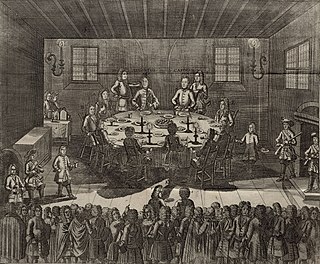Related Research Articles
The Treaties of Stockholm are two treaties signed in 1719 and 1720 that ended the war between Sweden and an alliance of Hanover and Prussia.

The Treaty of Bromberg or Treaty of Bydgoszcz was a treaty between John II Casimir of Poland and Elector Frederick William of Brandenburg-Prussia that was ratified at Bromberg (Bydgoszcz) on 6 November 1657. The treaty had several agreements, including the Treaty of Wehlau, signed on 19 September 1657 by the Brandenburg–Prussian and Polish–Lithuanian envoys in Wehlau. Thus, the Treaty of Bromberg is sometimes referred to as treaty of Wehlau-Bromberg or Treaty of Wehlau and Bromberg.
The Treaty of Frederiksborg was a treaty signed at Frederiksborg Castle, Zealand, on 3 July 1720, ending the Great Northern War between Denmark-Norway and Sweden.

The Treaty of Stettin of 13 December 1570, ended the Northern Seven Years' War fought between Sweden and Denmark with her internally fragmented alliance of Lübeck and Poland. It also settled Swedish, Danish, and Holy Roman Imperial claims regarding the Livonian War. Unfavourable for Sweden, the treaty assured Danish hegemony in Northern Europe for a short period. Yet, because of its inconclusiveness, it did not prevent further warfare between Denmark-Norway and Sweden, which ended only in the 1720s.

The Treaty of Teusina, Tyavzin or Tyavzino, also known as the Eternal Peace with Sweden in Russia, was concluded by Russian diplomats under the boyar Afanasiy Pushkin and ambassadors of the Swedish king at the village of Tyavzino in Ingria on 18 May 1595 to end the Russo-Swedish War (1590–95) between the powers.
The Treaty of Hamburg was signed on 22 May 1762 in the Free City of Hamburg between Sweden and Prussia during the Pomeranian War, a theater of the Seven Years' War.
The Treaty or Truce of Plussa, Pljussa, Plyussa or Narva and Plusa was a truce between Russia and Sweden, which ended the Livonian War (1558-1583). The truce was signed on 10 August 1583 at the Plyussa River north of the city of Pskov. The truce was set to expire in 1586, but was extended in 1585-1586.

The six-year Truce of Altmark was signed on 16 (O.S.)/26 (N.S.) September 1629 in the village of Altmark, in Poland, by the Polish–Lithuanian Commonwealth and Sweden, ending the Polish–Swedish War (1626–1629).
The Treaty of Preobrazhenskoye was negotiated by Johann Patkul and signed on 22 November 1699 in Preobrazhenskoye, a favoured residence of the tsar Peter the Great. It followed an informal meeting of Peter and Augustus at Rava in August 1698. The treaty called for the partition of the Swedish Empire among Denmark-Norway, Russia, Saxony and the Polish–Lithuanian Commonwealth. Following the treaty, the Great Northern War began.

The Peace of Travendal was a peace treaty concluded at the outset of the Great Northern War on 18 August 1700 between the Swedish Empire, Denmark–Norway and Holstein-Gottorp in Traventhal. Denmark had to return Holstein-Gottorp to its duke, a Swedish ally, and to leave the anti-Swedish alliance. The Danes only reentered the war after Sweden's major defeat in the Battle of Poltava, 1709, having used the time to reform their army. The treaty was guaranteed by France, the Holy Roman Empire, the United Provinces (Netherlands) and Great Britain.
The Treaty of Narva was concluded on 19 August (O.S.) / 30 August 1704 during the Great Northern War. The faction of the Polish–Lithuanian Commonwealth loyal to Augustus the Strong joined the anti-Swedish alliance between the Saxon electorate and the Tsardom of Russia.
The Treaty of Warsaw was concluded on 18 November (O.S.) / 28 November 1705 during the Great Northern War. It was a peace treaty and an alliance between the Swedish Empire and the faction of the Polish–Lithuanian Commonwealth loyal to Stanisław Leszczyński.

The Treaty of Thorn was concluded on 9 October 1709 between Augustus the Strong of Poland-Lithuania and Peter the Great of Russia in Thorn (Toruń), during the Great Northern War. The parties revived their alliance, which Charles XII of Sweden had destroyed in the Treaty of Altranstädt (1706), and agreed on restoring the Polish crown to Augustus.
On 22 October 1709, during the Great Northern War, the alliance between the Russian Empire and Denmark-Norway was renewed in the Treaty of Copenhagen. Charles XII of Sweden had destroyed the previous alliance in Travendal (1700). For Russia, Vasily Lukich Dolgorukov signed the treaty in Copenhagen.

The Treaty of Altranstädt was concluded between Charles XII of Sweden and Augustus the Strong of Saxony and Poland–Lithuania, on 13 October 1706, during the Great Northern War. Augustus had to renounce his claims to the Polish throne and his alliance with Russia.
The Treaty of Hanover was concluded on 3 July 1710, during the Great Northern War. It allied the Russian Empire with Brunswick-Lüneburg (Hanover). Though Hanover was not among the most important states of the Holy Roman Empire, the alliance was important since the Hanoveranian duke, with whom the alliance was concluded, was subsequently to become king of Great Britain as George I.
The Treaty of Schwedt was concluded on 6 October 1713, during the Great Northern War, between the Tsardom of Russia and Brandenburg-Prussia in Schwedt. Brandenburg-Prussia was promised southern Swedish Pomerania up to the Peene river, which had just been conquered by Russia. In turn, Brandenburg-Prussia accepted Russia's annexation of Swedish Ingria, Estonia and Karelia, and agreed to pay 400,000 thalers to Russia. Southern Swedish Pomerania was to be administered by Brandenburg-Prussia until a definite ruling in a peace treaty was reached.
The Treaty of Berlin was concluded on 2 May 1715, during the Great Northern War. It allied George I of Great Britain, as Elector of Hanover, with Denmark-Norway, in return for the cession to Hanover of the Swedish dominion of Bremen-Verden, which was occupied by Denmark. With the treaty, Denmark and Hanover joined the Russo-Prussian coalition that had been established by the Treaty of Schwedt. Denmark was assured the gain of yet-to-be-conquered Stralsund.
The Treaty of Stettin was concluded on 28 April 1715, during the Great Northern War, in the Prussian camp at Stettin between Hanover and Prussia. The treaty allied George I of Great Britain, as Elector of Hanover, with the Kingdom of Prussia against the Swedish Empire. In the years following the establishment of this treaty, Sweden was forced out of it holdings south of the Baltic Sea, ultimately leading to Sweden's defeat in 1721, at the conclusion of the Great Northern War.
The Treaty of Novgorod was concluded in August 1561, during the Livonian War, between Sweden and the Tsardom of Russia. It settled the common border, with Reval (Tallinn) submitted to Swedish rule since June, revised the truce established in the Treaty of Novgorod (1557) and renewed in early 1561 to last twenty years. The treaty was renewed and extended by the Treaty of Dorpat (1564).
References
This article includes a list of references, related reading or external links, but its sources remain unclear because it lacks inline citations .(November 2015) |
- Klonowski, Martin (2005). Im Dienst des Hauses Hannover. Historische Studien (in German). 485. Matthiesen. p. 89. ISBN 3-7868-1485-6.